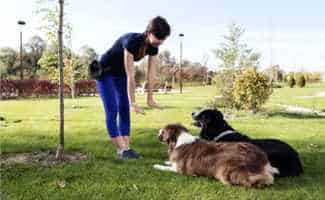
To keep the lights on, we receive affiliate commissions via some of our links. Our review process.
Just picture it: you get a new dog and can’t wait to introduce your new best friend to your friends and family. You have people over to meet your dog, and the dog chooses this time to reveal that they are terrible around strangers. Perhaps they bite your mother-in-law’s ankles, or they decide the middle of your living room is a great place to relieve themselves, over and over.
I think most people can agree that dogs are great. They provide companionship and make home environments happy. However, some dogs can be mischievous and need some effective dog training. Maybe they are puppies and are entirely untrained or older dogs who learned some bad habits over the years. Whatever your dog’s need, there are several options for training.
Research shows that 73% of dog owners seek out training for their dogs. This is a sharp increase from 57% in 2018. While some of these dog owners took on the task of training themselves, nearly half sought out a professional dog trainer.
The type of dog training you choose depends on your lifestyle, dog’s disposition, and availability. Each option offers its own benefits, and dog owners should do their due diligence to go with the right choice for their pet and their circumstances.
In-Home Training
Contents

In-home training has many benefits. You can work together with your dog from the get-go to foster your connection and apply valuable skills in your home setting, where your dog most often is. In-home training is precisely what it sounds like: the trainer will come to your home and instruct both you and your dog.
1. Train Where Your Dog Is Most Comfortable
Probably the most significant benefit of having a trainer come to you is that it considers your pet’s comfort level. Many dogs are homebodies, and training them in the home can allow them to learn necessary behavioral skills where they are most relaxed. Also, the dog will likely be home most of the time, so it makes sense for them to learn new, better behaviors in their home environment.
2. Hands-On Training For You, The Owner
With in-home training, owners can benefit from hands-on training and the ability to apply their newly acquired knowledge right away in their homes. Any trainer worth their salt will ensure they are thorough and that owners are at ease with their new skills before leaving each training session. Trainers should go over goals for the training with owners so everyone is on the same page.
3. Repetition Matters
When you have a trainer coming to you, you can’t just rely on times when the trainer is in your home to be the only instruction your dog receives. Owners have to be diligent to continue to practice their new skills with their dog when the trainer is not there. Repetition will help your dog adapt faster and help make newly learned obedience training skills second nature.
4. Communication Is Key
When deciding to go with in-home dog training, you commit to communicating openly with your dog trainer and being honest about the strides your dog (and you) are making towards successful training results. If you are struggling with the training program and applying newly learned techniques when the trainer is not in the home, that needs to be communicated to the trainer so they can make necessary adjustments. You won’t be successful if you don’t put the time into training your dog when your trainer isn’t there in between sessions. Your progress relies on your effort.
Having a private, in-home session with a dog trainer may seem like an expensive option. However, this option is super valuable since you get so much one-on-one help in your environment. In-home training also fits nicely with a lifestyle centered around the home, such as for remote workers or the physically disabled. Choose a trainer that offers packages instead of paying by the session for the best results. This ensures that you follow the steps needed to reach all of your goals.
Dog personality is also an important factor when considering in-home training. If one of your dog’s bad behaviors is aggression with other dogs, you may not want to have a training option that includes a lot of different canine classmates in the same room. If your dog is skittish around most people, it may be too difficult to break them out of that nervous behavior in a more heavily-attended training session.
Trainers can also benefit from an in-home session. Behaviors that a dog may need training for can sometimes be hard to replicate outside of the home. By allowing the dog trainer to see the dog in their “natural habitat” they can see the problematic behaviors on full display, where they usually occur. Trainers can also see the behaviors for themselves without relying on the owner’s explanation of the behaviors they want addressing.
In-home training can also be a bonding opportunity for owners and their dogs. This bonding time is crucial with puppies. However, bonding is also essential with newly adopted dogs of any age. When you’ve bonded with your dog, they will be eager to please you and work on their behavior.
Board And Train Services

Board and train is an approach that offers fully-immersive dog training. Dogs receive daily instruction and socialization with other people and dogs, and often trainers can get positive results in short order. This immersive approach can work well for people who want their dogs to be well socialized and comfortable around people, dogs, and distractions.
1. Great For Busy Owners
Board and train works great for busy folks. If an owner doesn’t have the time to devote to foundational training with their pet, sending them away for immersive training may be the answer.
2. Socialization Skills
Having an aggressive dog, or overly excitable around other people and other dogs, can be challenging. You may feel unable to have people over to your home, or you cannot have your dog participate in a doggy-daycare situation because of their behavior. Board and train obedience stresses socialization with people and other dogs. Trainers safely ease dogs into finding a comfort level around others.
3. Continuing The Training At Home
Good board and train trainers will still work with owners to instill skills that allow them to continue the training once the dog returns home. These trainers should follow up with their clients to ensure that all questions are answered and that the transition home from boarding is smooth.
Many dogs develop bad behaviors and habits in the home. Utilizing a board and train approach to dog training can effectively break destructive behaviors and habits. Sometimes, dogs can regress and try to “test” the newly learned rules and behaviors. They may try to revert back to their old behaviors after returning home. It takes a dedicated owner to reinforce the training once the dog is home and not allow a return to the behaviors that led to the need for training in the first place.
Board and train facilities are often incredibly structured, and dogs will quickly learn they cannot get away with mischief. Once a dog understands that their owner knows the new rules too, they will quickly fall into line at home.
Choosing The Right Option

Choosing the right training options for your dog comes down to many factors. Here are some things to consider when selecting a training option for your pooch.
1. Behaviors And Training Goals
What concerns you about your dog’s behaviors? What are your training goals for your dog? The answers to these questions may direct you to the correct training option. Don’t be afraid to speak with several trainers to know which person and type of training may work best for your dog.
2. Check Your Trainer’s Credentials And Reviews
Trainers should be experienced and, obviously, free from any charges of neglectful behavior with animals. Even a simple internet search can help you vet a potential trainer.
3. Make Yourself Part Of The Process
Whether you choose the in-home or board and train option, you should ensure the trainer believes in involving the owner in the training process.
4. Cost And Convenience Considerations
Cost does matter to many. When choosing a trainer, make sure you understand the cost, billing schedule, and what’s included. There’s a significant range of prices in the dog training industry.
5. Get Referrals
Much like researching potential trainers online, getting the opinion of people you know about possible trainers or training approaches can help you make a fully educated decision.
People always have high hopes when bringing a dog into their home, whether as a puppy or an older rescue. It can be frustrating when dogs have maladaptive behaviors or struggle to acclimate to their new surroundings. Training may be necessary if your goal is to have a well-mannered dog who gets along with visitors, kids, and other dogs. By researching and weighing your different options, you can find the best training approach for your lifestyle and your dog’s needs.
Elissa Weimer-Sentner is the founder and co-owner of Paw & Order Dog Training. Since opening in 2013, Paw & Order has developed into an established top-tier dog training company with the help of her husband and co-owner, Steve Sentner. They offer programs tailored to each dog’s needs and focus areas. Paw & Order specializes in all levels of dog training, including puppy training, basic obedience, and intense behavior modification, including working with dogs that have been deemed impossible to train.
Tagged With: